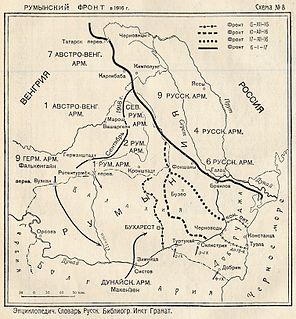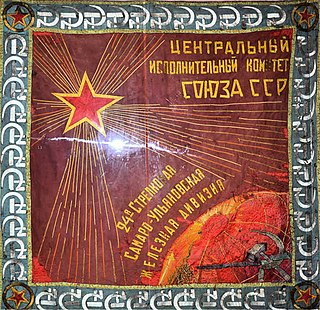
The Battle of Tannenberg, also known as the Second Battle of Tannenberg, was fought between Russia and Germany between 26 and 30 August 1914, the first month of World War I. The battle resulted in the almost complete destruction of the Russian Second Army and the suicide of its commanding general, Alexander Samsonov. A series of follow-up battles destroyed most of the First Army as well and kept the Russians off balance until the spring of 1915.

The Battle of Łódź took place from 11 November to 6 December 1914, near the city of Łódź in Poland. It was fought between the German Ninth Army and the Russian First, Second, and Fifth Armies, in harsh winter conditions. The Germans redeployed their Ninth Army around Thorn, so as to threaten the Russian northern flank, following German reversals after the Battle of the Vistula River. The German objective was to prevent an invasion of Germany, and thus considered a success, though narrowly avoiding disaster.

The Western Group of Forces (WGF), previously known as the Group of Soviet Occupation Forces in Germany (GSOFG) and the Group of Soviet Forces in Germany (GSFG), were the troops of the Soviet Army in East Germany. The Group of Soviet Occupation Forces in Germany was formed after the end of World War II in Europe from units of the 1st and 2nd Belorussian Fronts. The group helped suppress the East German uprising of 1953. After the end of occupation functions in 1954 the group was renamed the Group of Soviet Forces in Germany. The group represented Soviet interests in East Germany during the Cold War. After changes in Soviet foreign policy during the late 1980s, the group shifted to a more defensive role and in 1988 became the Western Group of Forces. Russian forces remained in the eastern part of Germany after the dissolution of the Soviet Union and German reunification until 1994.

The Second Battle of the Masurian Lakes, also known as the Winter Battle of the Masurian Lakes, was the northern part of the Central Powers' offensive on the Eastern Front in the winter of 1915. The offensive was intended to advance beyond the Vistula River and perhaps knock Russia out of the war.

The Battle of Galicia, also known as the Battle of Lemberg, was a major battle between Russia and Austria-Hungary during the early stages of World War I in 1914. In the course of the battle, the Austro-Hungarian armies were severely defeated and forced out of Galicia, while the Russians captured Lemberg and, for approximately nine months, ruled Eastern Galicia until their defeat at Gorlice and Tarnów.

The Battle of the Vistula River, also known as the Battle of Warsaw, was a Russian victory against the German Empire and Austria-Hungary on the Eastern Front during the First World War.

The Battle of Sarikamish was an engagement between the Russian and Ottoman empires during World War I. It took place from December 22, 1914, to January 17, 1915, as part of the Caucasus campaign.

The First Battle of the Masurian Lakes was a German offensive in the Eastern Front 2–16 September 1914, during the second month of World War I. It took place only days after the Battle of Tannenberg where the German Eighth Army encircled and destroyed the Russian Second Army. Using the rapid movements aided by the East Prussian railway network, the Eighth Army reformed in front of the spread-out Russian First Army and pushed them back across their entire front, eventually ejecting it from Germany. Further progress was hampered by the arrival of the Russian Tenth Army on the Germans' right flank.

The Gorlice–Tarnów offensive during World War I was initially conceived as a minor German offensive to relieve Russian pressure on the Austro-Hungarians to their south on the Eastern Front, but resulted in the Central Powers' chief offensive effort of 1915, causing the total collapse of the Russian lines and their retreat far into Russia. The continued series of actions lasted the majority of the campaigning season for 1915, starting in early May and only ending due to bad weather in October.

The Romanian Front was an army group level command of the Imperial Russian Army and the Romanian Army during the First World War.

The Russian 2nd Army was an army-level command of the Imperial Russian Army in World War I. It was formed just prior to the outbreak of hostilities from the units of Warsaw Military District and was mobilized in August 1914. The army was effectively destroyed at Battle of Tannenberg in August 1914. However, it was rebuilt soon thereafter and fought until almost the end of the war.
The 10th Rifle Division was a military formation of the Red Army. It existed by 1920, but was formally created on 20 June 1922, based on the 29th Infantry Brigade. It was then recreated at Vladimir in September 1939, and fought in the Second World War.
The Ranks and insignia of the Imperial Russian Armed Forces were the military ranks used by the Imperial Russian Army and the Imperial Russian Navy. Many of the ranks were derived from the German model. The ranks were abolished following the Russian Revolution, with the Red Army adopting an entirely different system.
The 1st Guards Tank Division was a tank division of the Soviet Army from 1945 to 1947, stationed in Neuruppin. It was formed in the spring of 1942 as the 26th Tank Corps. The corps fought in Operation Uranus and became the 1st Guards Tank Corps, being redesignated as a reward for its actions in December 1942. It fought in Operation Gallop, the Third Battle of Kharkov, Operation Kutuzov, Operation Bagration, the East Prussian Offensive, the East Pomeranian Offensive and the Berlin Offensive. During the East Prussian Offensive, the division captured Mława, Działdowo and Płońsk and was awarded the Order of Lenin for its actions. The division had been awarded the honorific "Don" for its actions in Operation Gallop. It also was awarded the Order of the Red Banner and the Order of Suvorov 2nd class.
The 56th Rifle Division was an infantry division of the Red Army and later the Soviet Army of the Soviet Union, formed three times.
The 12th Rifle Corps was an infantry corps of the Red Army during the interwar period and World War II, formed four times.

The 68th Mountain Rifle Division was a mountain infantry division of the Red Army before and during World War II.
The 84th Rifle Division was an infantry division of the Red Army before and during World War II.
The 46th Guards Rifle Division was formed as an elite infantry division of the Red Army in October 1942, based on the 2nd formation of the 174th Rifle Division, and served in that role until after the end of the Great Patriotic War. It was in the 6th Army of Voronezh Front when it won its Guards title, but was immediately moved to the Reserve of the Supreme High Command for rebuilding, where it was soon assigned to the 5th Guards Rifle Corps. In mid-November it moved with its Corps to join the 3rd Shock Army in Kalinin Front and played a leading role in the Battle of Velikiye Luki, both in the encirclement of the German garrison of that city and then in fighting off several relief attempts. It remained in the area through the spring and summer of 1943 before taking part in the breakthrough battle at Nevel and the subsequent operations to expand the salient and pinch off the German positions that 3rd Shock had partly surrounded. In June 1944 the 46th Guards was reassigned to the 6th Guards Army of 1st Baltic Front in preparation for Operation Bagration and made a spectacular advance into Luthuania through the "Baltic Gap" between Army Groups Center and North. The division would continue to serve in the Baltic states in 6th Guards for the duration of the war, winning the Order of the Red Banner in the process and ending on the Baltic coast in 22nd Guards Rifle Corps helping to contain the German forces trapped in the Courland Pocket. Despite a creditable record of service the division was disbanded shortly after the end of hostilities.

The Bug-Narew Offensive from July 13 to August 27, 1915 was a major German victory during World War I on the Eastern Front. The Imperial German Army broke through 4 heavily fortified positions, inflicted defeats on superior enemy forces and pushed the Russian Army 300 km to the east, capturing 215,000 prisoners. But the German army also suffered relatively heavy casualties, about 30,000 killed and missing.









